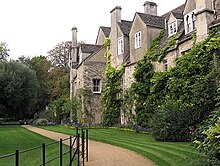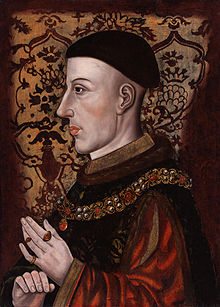Thomas Prestbury
To achieve this Shrewsbury Abbey deployed funding from Wrockwardine parish church, which had been granted to it by Roger Montgomery shortly after its establishment, as noted in the Domesday Book.
In 1333, referring to the request of King Edward and Queen Philippa, the Pope issued a mandate confirming the abbey's appropriation, so long as enough was left over to support a perpetual vicar.
'[6] It is not certain, however, that he was the Benedictine Thomas Scherusbury who was Chancellor of the University of Oxford in 1393-4: the identification is far from certain, although it appears as a fact in older sources, like Owen and Blakeway's History of Shrewsbury (1825).
[8] The circumstances of his election show that he was in some way involved in the conflicts of the time, when Richard II's authority, and ultimately kingship, were challenged by Henry Bolingbroke, although his precise rôle remains mysterious.
The next report of Prestbury's detention comes from Adam of Usk, an important supporter of Bolingbroke, who accompanied his army on its triumphal progress from Bristol to Chester.
If as Usk claims, he himself approached both Bolingbroke and Archbishop Thomas Arundel to secure Prestbury's release, the circumstance of their passing through Shrewsbury would explain the speed of his election.
[7] The mandate to restore temporalities, accompanied by the writ de intendendo, instructing the tenants to transfer their loyalty to Prestbury, was issued from Westminster on 7 September.
[1] In 1403 the turmoil following the change of régime became particularly acute at Shrewsbury, which was the scene of a major conflict between Henry IV and a coalition led by his former allies, the House of Percy.
[1] The disorder, which included the depredations of Owain Glyndŵr's troops, was such that on 20 May 1405 the abbey was dispensed, during Prestbury's lifetime, from paying the tenths, a key royal tax, on its properties outside the Diocese of Lichfield because of the damage done by to its lands by Welsh rebels.
[21] The donors included four gentry members of the Arundel affinity, probably acting on the Earl's behalf:[22] Robert Corbet, his younger brother Roger, their aunt's husband John Darras and William Ryman of Sussex.
[28] He set up a committee of twelve, initially at Oxford,[29] but later extended to both universities,[30] to determine which Wycliffite teachings and writings were to be condemned and banned.
A later chancellor, Thomas Gascoigne recorded that, as the commissary of the Bishop of Lincoln, Prestbury oversaw the burning of John Wycliffe's books at Carfax in the centre of Oxford, in 1410.
[31] In March 1411 the committees of 12 provided Arundel with a convenient list of 267 heretical propositions,[32] which he intended to use as a check-list in a visitation of Oxford University.
[30] Prestbury published notice of Arundel's intention to carry out the visitation of the university, provoking strong resistance to what was seen as an attack on academic freedom.
Although large numbers of the Arundel affinity and their opponents were indicted, the facts were disputed, the cases remanded and the accused pardoned after the magnates stood surety for them.
In February 1413 he received a general pardon from Henry IV, covering "all treasons, insurrections, rebellions, felonies, misprisions, offences, impeachments and trespasses.
[7] In December 1413 Prestbury was one of a group of eminent clerics commissioned to investigate and amend abuses at St Mary's Church, Shrewsbury, a royal free chapel:[35] a task that suggests he was essentially trusted by the king.
It may explain why John Burley, a veteran lawyer of Arundel's affinity and a man well past youth,[36] decided to prolong his relationship with Shrewsbury Abbey beyond death.
On 1 December 1414, working through agents who were mainly clerics, and for a fine of £20, he received a licence to alienate in mortmain to the abbey substantial holdings at Alveley on the River Severn.
Although united with the Crown since the accession of Henry IV, the palatinate had an administration and legal system distinct from the rest of England, headed by its Chancellor.
Apparently around 1416, this must have involved Henry V staying at Shrewsbury Abbey, which was the starting point for pilgrimages to Holywell: a mark of regard for Prestbury the abbot, if also expensive and diverting for him.
[42] The abbot of Burton Abbey was sent in and discovered that Prestbury was apparently trying to secure the succession for a monk called William Pule, against the will of most of the convent.
[43] He was succeeded not by his protégé, but by John Hampton, a monk of Shrewsbury favoured by the convent, who was confirmed by the bishop at Lilleshall parish church on 27 August.





